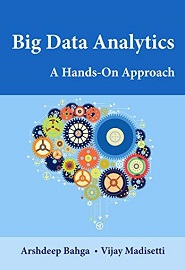
English | 2019 | ISBN: 978-1949978001 | 542 Pages | PDF | 109 MB
The book is organized into three main parts, comprising a total of twelve chapters. Part I provides an introduction to big data, applications of big data, and big data science and analytics patterns and architectures. A novel data science and analytics application system design methodology is proposed and its realization through use of open-source big data frameworks is described. This methodology describes big data analytics applications as realization of the proposed Alpha, Beta, Gamma and Delta models, that comprise tools and frameworks for collecting and ingesting data from various sources into the big data analytics infrastructure, distributed filesystems and non-relational (NoSQL) databases for data storage, processing frameworks for batch and real-time analytics, serving databases, web and visualization frameworks. This new methodology forms the pedagogical foundation of this book.
Part II introduces the reader to various tools and frameworks for big data analytics, and the architectural and programming aspects of these frameworks as used in the proposed design methodology. We chose Python as the primary programming language for this book. Other languages, besides Python, may also be easily used within the Big Data stack described in this book. We describe tools and frameworks for Data Acquisition including Publish-subscribe messaging frameworks such as Apache Kafka and Amazon Kinesis, Source-Sink connectors such as Apache Flume, Database Connectors such as Apache Sqoop, Messaging Queues such as RabbitMQ, ZeroMQ, RestMQ, Amazon SQS and custom REST-based connectors and WebSocket-based connectors. The reader is introduced to Hadoop Distributed File System (HDFS) and HBase non-relational database. The batch analysis chapter provides an in-depth study of frameworks such as Hadoop-MapReduce, Pig, Oozie, Spark and Solr. The real-time analysis chapter focuses on Apache Storm and Spark Streaming frameworks. In the chapter on interactive querying, we describe with the help of examples, the use of frameworks and services such as Spark SQL, Hive, Amazon Redshift and Google BigQuery. The chapter on serving databases and web frameworks provide an introduction to popular relational and non-relational databases (such as MySQL, Amazon DynamoDB, Cassandra, and MongoDB) and the Django Python web framework.
Part III focuses advanced topics on big data including analytics algorithms and data visualization tools. The chapter on analytics algorithms introduces the reader to machine learning algorithms for clustering, classification, regression and recommendation systems, with examples using the Spark MLlib and H2O frameworks. The chapter on data visualization describes examples of creating various types of visualizations using frameworks such as Lightning, pygal and Seaborn.
Resolve the captcha to access the links!